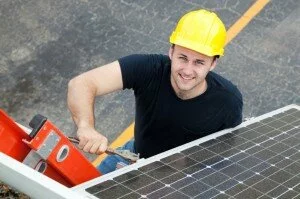Solar Roof Heater: Build it for less than $200.
Solar Roof Heater: Solar energy is the present, and is very much the future of renewable energy resources, when it comes to utilizing the energy to make the appliances work and conserve the energy resources which are currently being used and are in danger of getting used up.
Solar Roof Heater: This is important!
It is exactly due to this reason that, human beings went in search of energy resources which have the capacity to be replenished and have the tendency to be never ending.
After a widespread search, the researchers arrived at the conclusion that, harnessing the solar energy is the only way to conserve the energy resources and reduce the need for paying the extra amount in order to activate the appliances in your housing.
Solar Roofs is the general methodology that most house owners resort to, in a bid to save energy and also to reduce the electricity bill. The Solar Roof Heater is one such appliance that has made a mark in conserving electricity and also, deliver the best efficiency when it comes to the process of heating.
- General Mechanism By Which Solar Roof Heaters Can Be Operated.
Generally, the Solar Roof Heater consists of the solar roof which harnesses the solar energy and supplies it to the tank where the water gets heated up due to the heat supplied.
- The Solar Roof Heaters used to supply heat to the water, does an extremely good job during all seasons.
Though, most people had reservations about the winter due to the absence of sun, the Solar Roof Heater is absolutely at ease in switching to the mode where, a gas or electric booster is supplied to carry out the process.
Thus any type of Solar Roof Heaters comes along with an auxillary energy source. This source shall be connected to a gas or a central heating system which is activated automatically when the water in the tank falls below a minimum temperature which has been preset.
Solar Roof Heater: Make sure!
To ensure that the auxiliary energy source gets activated in a manner of simplicity and ease, the source for this energy sources shall range from the heat produced from a wood stove chimney to the usage of fossil fuels or electricity.
- Types Of Solar Roof Heaters And It’s Working.
As most good appliances, the Solar Roof Heaters also consist of varied types. Depending upon the sort of circuit, which is involved in heating up the water, the Solar Heaters are divided into direct or open loop and indirect or closed loop solar roof heaters.
The direct type of heaters are very efficient to produce potable water to the collector but their disadvantages extends from the fact that, they are unable to provide overheat and antifreeze protection which is coupled with the fact that it easily allows accumulation of scale in hard water areas.
- Hence they are mostly confined to cold climates.
The indirect type of heaters generally makes use of a heat exchanger that generally differentiates between the potable water and the heat transfer fluid.
On the whole, both direct and indirect solar roof heaters can be subdivided into two types such as active and passive solar heaters. The passive mechanism rely on heat convection for the transfer of heat transfer fluid or potable water and it’s construction and maintenance costs less while, the active mechanism uses taps for the transfer of fluids and it’s maintenance is far higher.
Solar Roof Heater: Design And Safety Precautions With Regards To Solar Roof Heaters.
The Solar Roof Heaters are designed based on a few general characteristics such as, the general temperature of the locality and the amount of water required as output from the system, changes in temperature due to a switch over in seasons or due to the recurrent day-night cycle and also, due to the possibility of over heating or freezing.
The minimum requirements of the Solar Roof Heaters are judged during the winter, when the amount of temperature required to heat up the water is maximum and the output of the system is at it’s lowest.
The maximum output is measured by figuring out ways to avoid over heating or prevent wastage of money on components which are not an absolute necessity.
- Overheating can be avoided by using the drainback system.
This is extremely efficient for, the pumps gets shut off when the system reaches a preset temperature. Appropriate freeze control mechanisms have to be undertaken to prevent damage to the system.
 Drainback systems drain out the freezing transfer fluid when the pump stops it’s process and indirect systems use an antifreeze such as propylene glycol in the heat transfer fluid.
Drainback systems drain out the freezing transfer fluid when the pump stops it’s process and indirect systems use an antifreeze such as propylene glycol in the heat transfer fluid.
Most direct Solar Roof Heaters use a manual draining system while a few others use freeze tolerant collectors made of flexible polymers such as silicone rubber.
Thus, with so much advancements being made in the field of harnessing solar energy, it’s high time that people start to buck up and begin using it to get better results when it comes to conserving energy.
(c) https://solarrooftilesreview.com/: Solar Roof Heater

